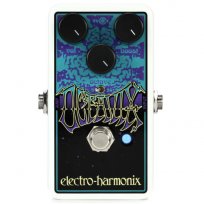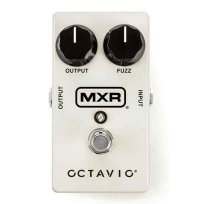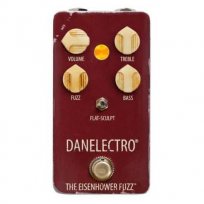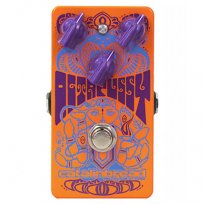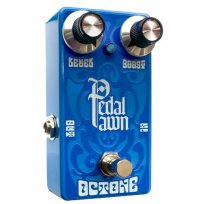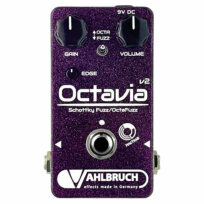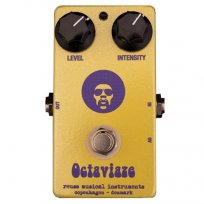
List Updated on March 09, 2023
The original Octavia Fuzz circuit was designed in 1967 by engineer Roger Mayer specifically for Jimi Hendrix. The circuit uses ring modulation and frequency doubling to create an octave up above whatever you are playing. The resulting signal is then sent to a fuzz.
However, the effect wasn’t available commercially until the early ’70s, when a Californian company called Tycobrahe released what Roger Mayer refers to as an “inaccurate rip-off” of his circuit, also called Octavia. Mayer later created his own manufacturing company through which he released many versions of the pedal; there are currently two available with different shaped cases. A few years ago, to put things straight, he penned a history of the Octavia, and also shot a 2020 video talking about a vintage unit used by Hendrix he was able to buy back at an auction.
How to Play the Octavia Fuzz
The Octavia’s circuit is all analog, of course, so no polyphonic pitch tracking here – you have to play to the pedal, so to speak. It works best first in the pedal chain and with single-coil pickups. To really bring out the upper octave sound, play one note at a time above the 10th fret on the neck pickup, with the fuzz turned down some. Turning the gain up will result in a more straight-up chunky vintage fuzz sound. The sound of the Octavia can most famously be heard on Hendrix’s solos for “Purple Haze” and “Fire” in his 1967’s debut album.
Octavia vs. Univox Super Fuzz
Although the Octavia was the first octave-up fuzz heard on a record, the first commercially available fuzz of that kind was the Univox Super Fuzz, introduced in 1968. Rather interestingly, we weren’t able to find relevant information about the difference in sound between these two effects.
The Original: Roger Mayer Octavia Fuzz
After designing pedals for Jimi Hendrix, in the ’70s Roger Mayer started his own studio recording equipment company and designed consoles and pro analog recording gear. His company is still going today, and he builds his classic effects, like the Octavia, with studio-grade components and a focus on recording applications. The Octavia Classic comes with one hard-wired output and two buffered outputs, for various routing options, while the Rocket version is a simpler, yet wild-looking, two-knob device.

Roger Mayer Octavia Rocket
Just two knobs like the original (Fuzz and Volume), in a large spaceship-shaped case that will impress sci-fi fans.
Roger Mayer Octavia Classic
The sound is the same as its rocket sibling, but it features a more compact case, a Tone knob placed between the drive and the octave stages for extra flexibility, and a true hard wire output plus two buffered outputs that can drive long cable lengths with no high-frequency loss.
—
—
The Vintage Octavia Clone

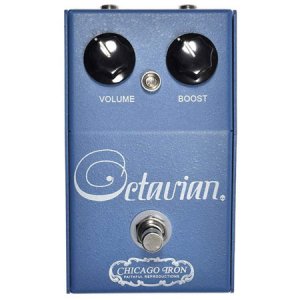
This was the first Octavia fuzz ever released commercially, and even though it wasn’t designed by Roger Meyer (who considers it an incorrect knock-off of an earlier 24-volt version), it took a life of its own and it’s now cloned as much as the Roger Mayer one. Vintage units are quite rare and sell for close to $1,000. Chicago Iron Works owns the brand and offers a Tycobrahe Second Edition Octavia that’s an exact replica of the original and costs $355. Some older units have the Chicago Iron logo on them and are named “Octavian.”
Today’s Best Octavia Fuzzes: Modern Clones & Evolutions
Due to the Jimi Hendrix connection, the Octavia has a legendary status in the history of rock’n’roll. This, together with the rather high price of the Roger Mayer and Tycobrahe reissues, make it a great candidate for cloning. In this list, you’ll find several Octavia-inspired pedals from a variety of builders.
- EHX Octavix
Mike Matthews was one of Jimi Hendrix’s closest friends, so you can be sure EHX knows how to do octave fuzz. Their Octavix is a great-sounding Octavia clone with an added control for the level of the octave up, for a more flexible, and yet affordable, take on this circuit. - MXR Octavio Fuzz
Jimi Hendrix used to refer to the Octavia as the “Octavio,” and since Dunlop (which owns MXR) has some kind of exclusive deal on the use of the guitarist’s image, it goes without saying that the company’s Octavia fuzz clone would sport that moniker anding in “o.”. It’s a faithful recreation of the original, at an affordable price point. - Fulltone Octafuzz
An affordable pedal used by many pros, Mike Fuller’s Octafuzz takes the original two-knob Octavia design and puts it in a compact enclosure, adding a fuzz/octave toggle switch. Flipping the switch down bypasses the octave effect for a huge-sounding badass vintage fuzz. - Danelectro Eisenhower Fuzz
In all likelihood based on the Octavia, this pedal adds flexibility to the original through Treble and Bass knobs and a Flat-Sculpt toggle switch that adds more bass and scoops the mids, while the Flat setting keeps the original’s mid hump and controlled lows. - Catalinbread Octapussy
An original circuit utilizing 3 silicon transistors, two diodes, and a custom-voiced preamp section, this octave-up fuzz belongs squarely to the Octavia evolution category. Unlike the original, it produces a more dynamic response and produces usable tones everywhere on the neck. A third Body knob allows for extra low end and harmonic content. - Dunlop Jimi Hendrix ’69 Psych Mini Octavio Fuzz
Vintage fuzzes lend themselves especially well to mini enclosures because of their typically simple circuits, small control set, and tendency to be placed first in the signal chain. Dunlop’s Hendrix signature mini Octavio is a faithful remake of the original circuit, with a toggle-able octave effect. - Pedal Pawn Octone
The result of hundreds of hours (and thousands of Sterling Pounds!) spent researching the ideal octave-up fuzz sound, The Octone faithfully recreates the original’s fuzz circuit, while the builder went the extra mile to improve the octave circuit to make it as clean as possible and clearly audible at high Boost setting and when playing above the 12th fret. - Vahlbruch Octavia V2
This high-end, hand-made German pedal uses a custom-made transformer and Schottky diodes to reproduce the sound of the vintage units (v1 used new old stock germanium ones). A toggle switch lets you bypass the octave-up effect, and V2 adds a small Edge knob that varies the treble and harmonic content of the fuzz, allowing for a wider spectrum of tones. - King Tone Octaland Mini
The most fully-featured Octavia evolution out there, it costs a small fortune but gives you three voicings (Regular, Vintage, and “Fullfat”) and control over Tone and Blend, which lets you mix to taste the pure octave tone and a clean/fuzz tone. It also sports a hotter Output. The original non-mini version of this pedal is extremely rare. - Chicago Iron Octavian Plus
An evolution of the Tycobrahe with added features requested by players: a foot-switchable octave; a 60’s/70’s toggle switch that lets you to switch between different voices the pedal had in the two decades; a dual-color indicator LED that shows red for fuzz and green for octave; bigger knobs that can be adjusted with the foot. - Dr. No Effects TVL Octavia
A creepy-looking Octavia clone born out of a collaboration with Queens of the Stone Age’s guitarist Troy van Leeuwen, featuring custom skull-shaped knobs and a heart-shaped, anatomically correct on/off light. The left “Blameshifter” knob sets the gain of the Octavia, delivering a range of fuzz tones from nasty to sweet. - Tru-Fi Octavia Fuzz
An authentic clone of the vintage Tycobrahe Octavia with an extra switch to turn the octave off. - Reuss Octaviaze
A high-end clone of a vintage Octavia built with new old stock germanium transistors and diodes in place of the original silicon ones, which give it a warmer and less abrasive sound.
You can find a few more Octavia clones that don’t have a video here on Reverb.com.
Octavia Fuzz Shoot Out
















